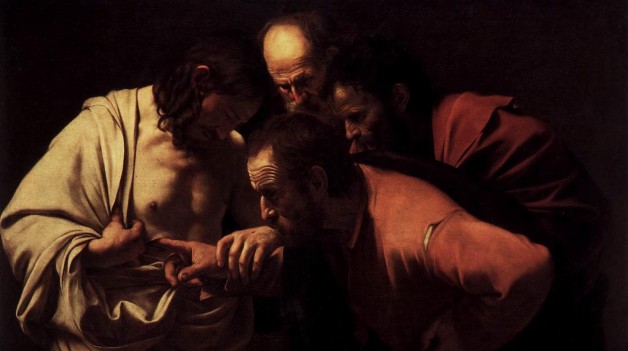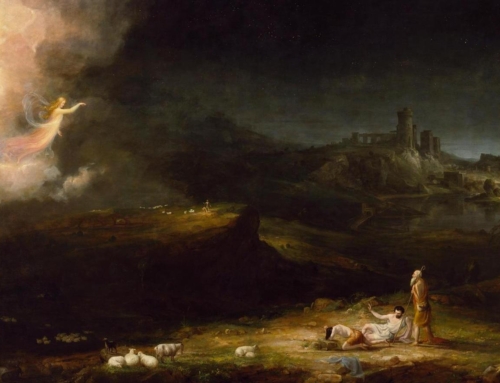On the same day that Peter stood stupefied at Jesus’ empty tomb, the risen Lord walked with two of his disciples to the village of Emmaus, seven miles from Jerusalem. There, he sat down to share a meal with them, and in the breaking of the bread they finally recognized their Teacher, who promptly vanished from their sight. Immediately, St. Luke tells us, the astonished pair returned to Jerusalem and (breathlessly, it would seem) told the Eleven what had happened. Then, as they heard the news that the Lord had also appeared to Simon Peter, Jesus himself
stood in their midst and said to them, “Peace be with you.” But they were startled and terrified and thought that they were seeing a ghost. And he said to them, “Why are you troubled? And why do questions arise in your hearts? Look at my hands and my feet, that it is I myself. Touch me and see, because a ghost does not have flesh and bones as you can see I have.” And as he said this, he showed them his hands and his feet. While they were still incredulous for joy and were amazed, he asked them, “Have you anything here to eat?” They gave him a piece of baked fish; he took it and ate it in front of them (Luke 24:36–43).
They thought they were seeing a ghost. Anything, they thought, was more likely than that Jesus himself was standing before them in the flesh. So he said, “Touch me and see,” and he ate “in front of them”—since it seems they were too astonished to eat anything themselves. To such great lengths did Jesus go to prove his humanity, his bodiliness, in the risen state (cf. John 20:27 and 21:12–15).
Incidentally, this account is sometimes contrasted with Mary Magdalene’s encounter with the risen Christ as recorded in the Gospel of John (20:11–18). On that occasion, Jesus’ words are, “Do not touch me, for I have not yet ascended to the Father.” As Ronald Knox points out, however, the meaning of the Greek here is not so much noli me tangere (“do not touch me”) as it is, “Stop holding on to me” or “Stop clinging to me.” The form of the verb presupposes that Mary is already touching Jesus—probably embracing his feet, just as she had done at the foot of the Cross. And how moving, and what a cause for hope this is, that Jesus chose to appear first, not to Peter, the leader of the Apostles, or to John, the beloved disciple, but to a penitent sinner (Mark 16:9).
Jesus, then, was not afraid of being touched or embraced in his risen state. On the contrary, he took great pains to show his disciples, by means of touch, that he had risen in the flesh. And this, to say the least, is an interesting point.
While belief in the soul’s immortality is something that naturally commends itself to our minds—it has always been fairly widespread, even among non-Christians—the resurrection of the body is a wholly unexpected and distinctively biblical doctrine. If it was hard for the Apostles to believe, it would have been patently absurd to their pagan contemporaries. The tendency of the ancient world, as of our post-Cartesian age, was to identify the person with the soul (or, in modern terms, “consciousness”), and to regard the body as, at best, a mere shell or encumbrance, the death of which is no loss to the spiritually mature. On this view, the body is either a vile and filthy thing, to be hated and starved, or it is a mere mechanism of pleasure, the plaything of one’s real self, i.e., the conscious mind. In either case, it is extrinsic to one’s humanity, and can be treated accordingly. Hence the pitiful refrain of the sexual revolution: “It didn’t mean anything.”
The Christian view is radically different. St. Thomas sums it up in the memorable line, Anima mea non est ego: “My soul is not I.” Whether we speak in biblical or Aristotelian terms—St. Thomas is commenting on St. Paul here—the point is this: we are not spirits trapped inside bodies, but rather complex unities of body and soul. We are both spiritual and physical beings, and we are both essentially. Consequently, the death of the body is a real deprivation, and its resurrection, in a glorified state, is a real restoration. Moreover, as an essential part of our nature, the body has profound significance for our moral and spiritual lives; it cannot be an extrinsic add-on, which is either loathed, on the one hand, or worshipped, on the other. Certainly, its place is subordinate to that of the soul, which is the seat of the intellect and will, but it is nevertheless “the temple of the Holy Spirit,” and, like every part of human nature, Christ assumed it, redeemed it, lives in it, and even now glorifies it.
We must never lose sight of this spectacular, earth-shattering truth, that, if we live in God’s grace here below, the glorified bodily life of Jesus Christ will someday be our own. He is the pledge of our future glory. He is the first fruits of the Resurrection. And we are his harvest.
✠
Image: Caravaggio, The Incredulity of Thomas







